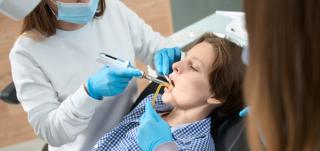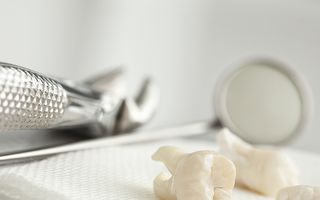
Wisdom Teeth and Tooth Extractions
Wisdom teeth are the third and final set of molars that most people get in their late teens or early twenties. Sometimes these teeth can be a valuable asset to the mouth when healthy and there is adequate room for them to erupt, but more often than not, they lack room to erupt which can result in problematic alignment and require removal.
Wisdom teeth present potential problems when they are misaligned and don’t have adequate room to erupt – they can position themselves horizontally, be angled toward or away from the second molars or be angled inward or outward.
Poor alignment of wisdom teeth can damage adjacent teeth, the jawbone, or nerves. Wisdom teeth that lean toward the second molars make those teeth more vulnerable to decay by trapping plaque and debris.
In addition, wisdom teeth can be trapped within the gum and/or the jawbone or only partially break through the gum. Teeth that remain partially or completely entrapped within the gum and/or the jawbone are known as “impacted.”
Wisdom teeth that only partially erupt allows for an opening for bacteria to enter around the tooth and cause infection, which results in pain, swelling, jaw stiffness, and general illness. Partially erupted teeth are also more prone to tooth decay and gum disease because their hard-to-reach location and awkward positioning makes brushing and flossing difficult.
When is the extraction of wisdom teeth generally recommended?
Extraction of wisdom teeth is generally recommended when:
- Wisdom teeth are only partially erupted. This leaves an opening for bacteria to enter around the tooth and cause an infection. Pain, swelling, jaw stiffness and general illness can result.
- There is a chance that poorly aligned wisdom teeth will damage adjacent teeth.
- A cyst (fluid-filled sac) forms, destroying surrounding structures such as bone or tooth roots.
Patients should ask the dentist about the health and positioning of their wisdom teeth. The dentist may make a recommendation for removal of the wisdom teeth or refer the patient to an oral surgeon for further evaluation
What does recovery involve?
How quickly you heal depends on the degree of difficulty of the extraction (a simple extraction of a fully erupted tooth versus a tooth impacted into the jawbone).
In general, here’s what to expect. Our Dentists will explain what to expect in your specific case.

During the first 24 hours
Bleeding may occur for several hours after tooth extraction
Facial swelling in the area where the tooth was extracted typically occurs
Pain medications, such as paracetamol or ibuprofen, can be taken for minor pain. One of our Dentists or a oral surgeon may prescribe more potent pain relievers, such as panadeine forte, if necessary.
Foods should be chewed on the side of the mouth opposite the extraction. Avoid hot liquids and alcoholic beverages for at least 24 hours. In the case of difficult extractions, consume a soft or liquid diet for the first 24 hours.
Continue to brush your teeth, but avoid the teeth directly next to the extracted tooth during the first 24 hours. On day two, resume the gentle brushing of your teeth.

After 24 hours
Facial swelling in the area of the tooth extraction will continue for about another day and then typically starts to reduce
Rinse your mouth with warm salt water (1/2 teaspoon of salt in a cup of warm water) after meals and before bed
Stitches, if used and if not of the self-dissolving type, need to be removed
Watch for signs of dry socket (described below).
Complete healing doesn’t occur for a few weeks to a few months following the extraction. However, usually within the first week or two, enough healing has taken place for use of your mouth to be reasonably comfortable in the area of the extraction.
Frequently asked questions
Wisdom teeth presence and position is identified through visual examination as well as through panoramic radiography. These sophisticated digital x-rays can tell us if wisdom are present or absent, if the roots are completely developed, the position of the teeth in relation to the nerve which supplies sensation to the jaw and whether the wisdom teeth have resulted in any pathology such as cysts or abscesses. Furthermore, these images show us the facial structures from the eyes down, so we can also assess the sinuses and other facial bones which can sometimes result in hidden pathology being discovered.
We may recommend that your wisdom teeth be removed even before problems and/or symptoms present. This is to avoid complications such as infections, decay to adjacent teeth, potential crowding and complications in removal. Removal of wisdom teeth is easier in young people as the roots are generally not completely developed and the jaw is less dense. In older people, recovery and healing time tend to be longer.
A wisdom tooth that is fully erupted through the gum can be removed as easily as any other tooth. However, a wisdom tooth that is underneath the gums and embedded in the jawbone will require an incision into the gums and then removal of the portion of bone that lies over the tooth. In this situation, the tooth will generally be removed in small sections rather than removed in one piece to minimize the amount of bone that needs to be removed to get the tooth out.
Two of the more important complications include:
- Dry socket: A dry socket is a common complication that occurs when either a blood clot has failed to form in the extracted tooth socket or the blood clot that did form has been dislodged. Without clot formation, healing will be delayed. A dry socket typically occurs 3 or 4 days following the extraction and is accompanied by pain (ranging from “dull” to moderate to severe) and a foul mouth odour. Often people report pain that is getting worse rather than better. Dr Osie will treat the dry socket by placing a medicated dressing in the socket. This typically will provide pain relief within minutes.
- Paresthesia: Paresthesia is an uncommon complication. Wisdom teeth that are impacted in the jawbone can be close to nerves that supply sensation to the jaw and tongue. Sometimes these nerves can be bruised or damaged during the tooth removal process. The result is a numbness (called paresthesia) of the tongue, lip or chin that can last a few days, weeks, months or may even be permanent.


